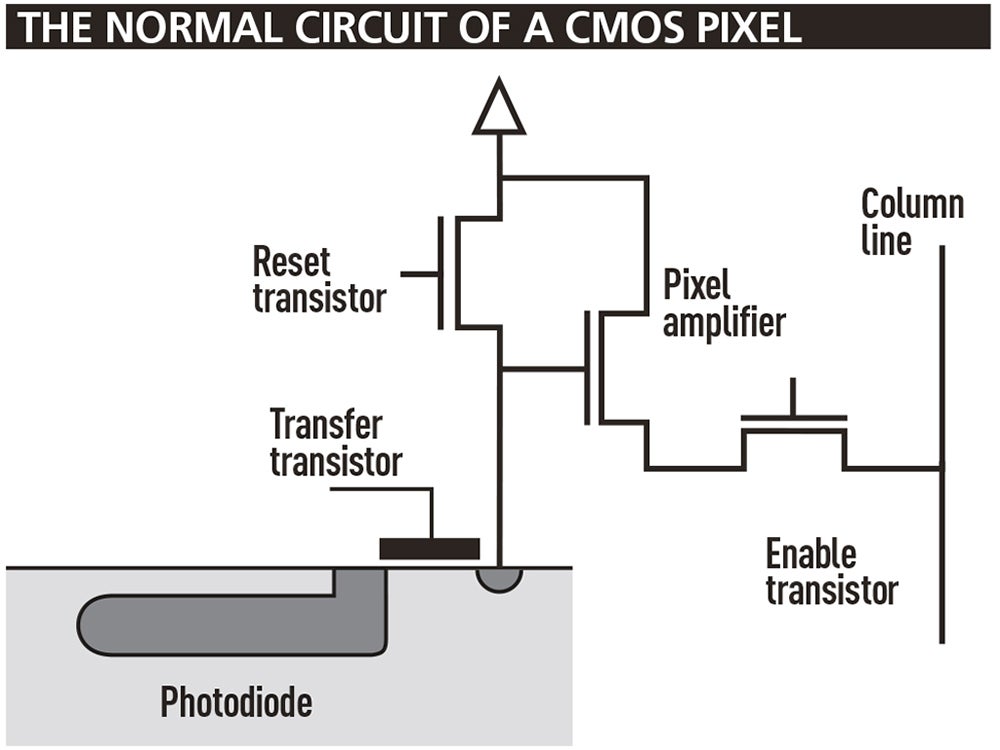Bob Newman discusses how electronic shutters work and the operation of the most common shutter types
Modern cameras often have some electronic shutter facility, be it an ‘electronic first curtain’ to eliminate so-called ‘shutter shock,’ ultra-high shutter speeds or global shutters for video. In this article I will discuss the working of electronic shutters.
To understand an electronic shutter, we first need to look at how a CMOS sensor works. The diagram shows the normal circuit of a CMOS pixel. It has four transistors, three of which effectively operate as switches. I have labelled them reset transistor, transfer transistor, pixel amplifier and enable transistor. The operation of electron capture goes as follows. First, the reset and transfer transistors are turned on. This clears the accumulated charge from the pixel transistor and the photodiode, readying the pixel for a new exposure. Next, both transistors are turned off, allowing photo charge to accumulate on the photodiode, which is now isolated from the pixel amplifier. The pixel amplifier (it multiplies the tiny charge in the pixel so it’s large enough to be read by following circuitry) is now outputting a charge-amplified version of the reset charge. This can be read by the downstream circuitry by turning on the enable transistor to feed its signal to the column output line. This reset signal will later be subtracted from the photosignal to eliminate reset noise. At the end of the exposure, the transfer transistor is switched on again, transferring the accumulated charge to the pixel amplifier, which now outputs a charge-amplified version of the photocharge and is enabled onto the column output line as before. Exposure time, for the pixel, lasts from when the reset and gate transistors were turned off and charge began to accumulate, to when the gate transistor was turned back on so the accumulated charge could be read.
Now to discuss how different shutter modes operate. In the interest of maximising exposure time in video modes, it is desirable that the exposure be ended just before the row of pixels is read. As all the pixels in a column share one output line, they have to be read one after the other. So if the exposure is stopped just in time, we have the effect that the exposure is stopped later further down the sensor. As soon as the row is read, the next exposure can be started so each row receives the same exposure. This leads to a ‘rolling’ effect that can cause distortions to the shape of moving objects. The way to solve this is to use a ‘global’ shutter, where the exposure in all rows is started and ended at the same time. The disadvantage is that the maximum exposure is shorter, as there is now a dead time between frames long enough for all the pixel rows to be read out. Ultra-high shutter speeds can be achieved simply by allowing a very short time between the start end of the exposure. As no moving parts are used, there is no inertia, and short exposure times are relatively easily achieved. Finally, the electronic first curtain is a derivative of the rolling shutter.
Here the timing of exposure start, row by row, is controlled to mimic the progress of the first blind of a focal plane shutter. A real blind performs the closing, but as that comes to rest after the exposure is finished, any vibration is invisible.

Bob Newman is currently Professor of Computer Science at the University of Wolverhampton. He has been working with the design and development of high-technology equipment for 35 years and two of his products have won innovation awards. Bob is also a camera nut and a keen amateur photographer





